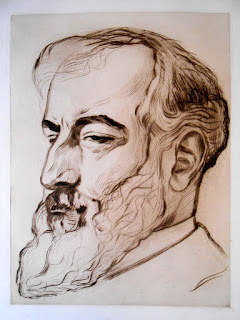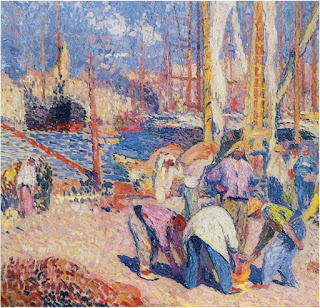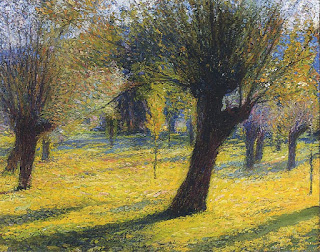Martin was born in Toulouse in southwestern France on August 5, 1860, to a French father who worked as a cabinetmaker and a mother of Italian descent. He enrolled at the Ecole des Beaux-Arts in Toulouse in 1877, studying under Jules Garipuy and Eugène Delacroix. Martin received a scholarship in 1879 that allowed him to move to Paris and join the studio of Jean-Paul Lauren, where he continued his education. He was awarded a gold medal for a work displayed at the Paris Salon in 1883 — a painting based on the work of the poet Dante. A second scholarship the following year allowed him to travel to Italy and study the works of the classical Italian masters, such as Giotto and his contemporaries.
The techniques and aesthetics he imbibed while studying in Italy were used in his subsequent works. It was here that Martin discovered the short, distinct brushstrokes that were reminiscent of George Seurat’s Pointillism. Yet, Martin’s use of the technique was distinct from Seurat, the Impressionists, and post-Impressionists, as he painted conventional subjects in this distinct style. Most of his paintings from this period were landscapes.
Henri-Jean Guillaume Martin's Awards and recognition
In 1880, Martin was made an officer of the Ordre national de la Légion d'honneur, the French order of merit established by Napoleon Bonaparte in 1802. His first solo exhibition was held at the Paris Salon in 1886. Three years later, he won another prize at the Paris Salon. Martin was offered and accepted commissions to do the decorations for municipal buildings all through France.
In 1880, Martin was made an officer of the Ordre national de la Légion d'honneur, the French order of merit established by Napoleon Bonaparte in 1802. His first solo exhibition was held at the Paris Salon in 1886. Three years later, he won another prize at the Paris Salon. Martin was offered and accepted commissions to do the decorations for municipal buildings all through France.
He won further acclaim when he received the Grand Prize at the World Fair in 1900. At the turn of the century, Martin increasingly began to present his work in spaces connected with Symbolist painters.
Henri-Jean Guillaume Martin's Middle Years
Partly due to his introverted personality, Martin decided to leave the busy art world of Paris in 1900. He searched for a decade before moving to Marquayrol, a mansion near Cahors in the south of France. He continued to paint in Marquayrol, incorporating tranquil scenes of the natural beauty of the rural landscape in his work. In his later life, Martin also traveled to Toulouse to visit his childhood home and painted its architecture and surrounding areas.
Partly due to his introverted personality, Martin decided to leave the busy art world of Paris in 1900. He searched for a decade before moving to Marquayrol, a mansion near Cahors in the south of France. He continued to paint in Marquayrol, incorporating tranquil scenes of the natural beauty of the rural landscape in his work. In his later life, Martin also traveled to Toulouse to visit his childhood home and painted its architecture and surrounding areas.
Henri-Jean Guillaume Martin's Later years
Martin was made Commander of the Legion of Honor in 1914, and in 1918, became a member of the Institute. Martin showed his work regularly at the Venice Biennale in the early 20th century. He also exhibited in other parts of Europe, including Germany, Iceland, and Belgium. Some of Martin’s well-known works are “The Harvest” (1895), “In the Garden” (1904), and “The Blue Dress” (1917).
Martin was made Commander of the Legion of Honor in 1914, and in 1918, became a member of the Institute. Martin showed his work regularly at the Venice Biennale in the early 20th century. He also exhibited in other parts of Europe, including Germany, Iceland, and Belgium. Some of Martin’s well-known works are “The Harvest” (1895), “In the Garden” (1904), and “The Blue Dress” (1917).
He died on November 12, 1943, in Marquayrol. The museum in Cahors started in 1833, is named the Musée de Cahors Henri-Martin in honor of the artist. You can buy Henri-Jean Guillaume Martin's artworks online.
Henri-Jean Guillaume Martin's Major Exhibitions
1880 - Salon des Artistes Francais, Paris
1889 - La Fete de la Federation, Paris
1892 - Salon de la Rose Croix, Paris
1893 - Munich Secession, Munich
1896 - La Libre Esthetique, Brussels
1898 - Vienna Secession, Vienna
1900 - Exposition Universelle
2009 - Musée de la Chartreuse, Douai
2009 - Musée des Beaux-Arts, Bordeaux
2009 - Musée Rignault, Saint-Cirq Lapopie
2009 - Musée Cahors, Cahors
2014 - Armand Hammer Museum of Art, Los Angeles
2014 - Duncan R Miller Fine Art, London
1880 - Salon des Artistes Francais, Paris
1889 - La Fete de la Federation, Paris
1892 - Salon de la Rose Croix, Paris
1893 - Munich Secession, Munich
1896 - La Libre Esthetique, Brussels
1898 - Vienna Secession, Vienna
1900 - Exposition Universelle
2009 - Musée de la Chartreuse, Douai
2009 - Musée des Beaux-Arts, Bordeaux
2009 - Musée Rignault, Saint-Cirq Lapopie
2009 - Musée Cahors, Cahors
2014 - Armand Hammer Museum of Art, Los Angeles
2014 - Duncan R Miller Fine Art, London









































































































































































































































































































































































































































No comments:
Post a Comment